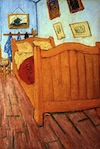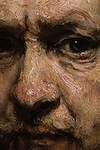In our little town of Nashville, the photographer Jeremy Cowart is something of a rock star. I suspect his renown is growing all around the world. When you consider that he’s made pictures of Sting, Imogen Heap, Carrie Underwood, Taylor Swift, Courtney Cox, Maggie Gyllenhaal, Ryan Seacrest, and traveled with Britney Spears in 2009 as her tour photographer, some fame and name recognition makes sense.
My favorite project that Jeremy envisioned is one called Help Portrait. Help Portrait is a world-wide movement stirring the hearts and hands of photographers to find someone in need, take their portrait, print it, and give it to them for free.
 If, however, you are a person who needs to gear up to visit an art museum, if you feel anxious about the way these hallowed halls of priceless history and beauty leave you feeling — how should I say it? — a little dumb, read on. I’m going to tell you how to walk into an art museum like you own the place. I’m going to liberate your conscience, affirm your intelligence, give you focus, and teach you how to develop a lifelong love of not only art but of the museums that house it.
If, however, you are a person who needs to gear up to visit an art museum, if you feel anxious about the way these hallowed halls of priceless history and beauty leave you feeling — how should I say it? — a little dumb, read on. I’m going to tell you how to walk into an art museum like you own the place. I’m going to liberate your conscience, affirm your intelligence, give you focus, and teach you how to develop a lifelong love of not only art but of the museums that house it. If, however, you are a person who needs to gear up to visit an art museum, if you feel anxious about the way these hallowed halls of priceless history and beauty leave you feeling — how should I say it? — a little dumb, read on. I’m going to tell you how to walk into an art museum like you own the place. I’m going to liberate your conscience, affirm your intelligence, give you focus, and teach you how to develop a lifelong love of not only art but of the museums that house it.
If, however, you are a person who needs to gear up to visit an art museum, if you feel anxious about the way these hallowed halls of priceless history and beauty leave you feeling — how should I say it? — a little dumb, read on. I’m going to tell you how to walk into an art museum like you own the place. I’m going to liberate your conscience, affirm your intelligence, give you focus, and teach you how to develop a lifelong love of not only art but of the museums that house it.






















